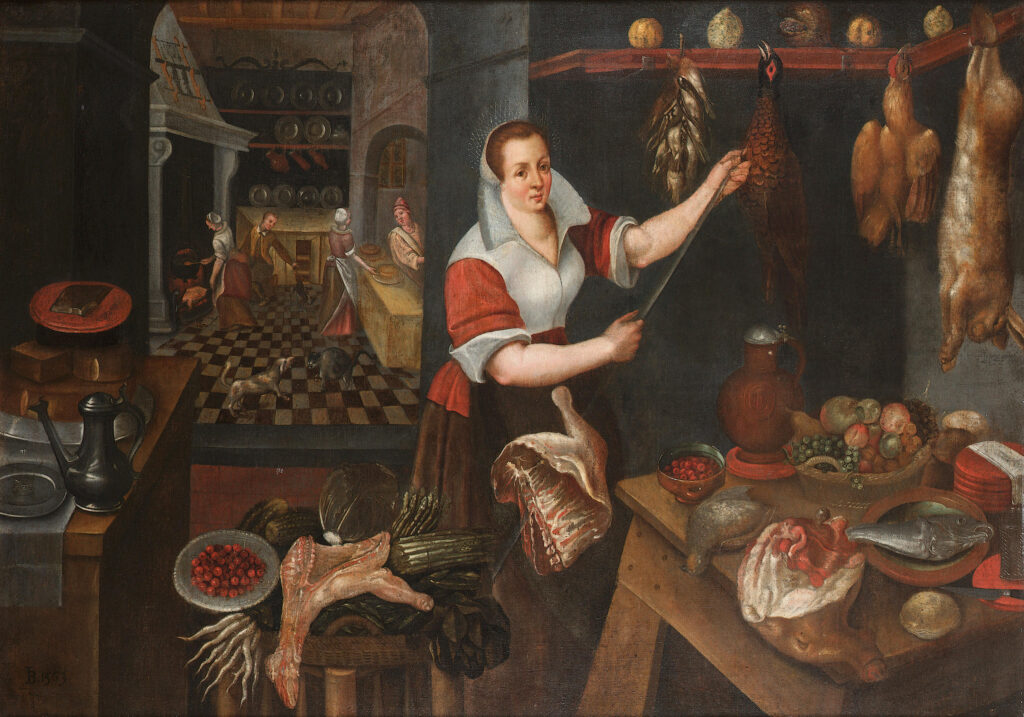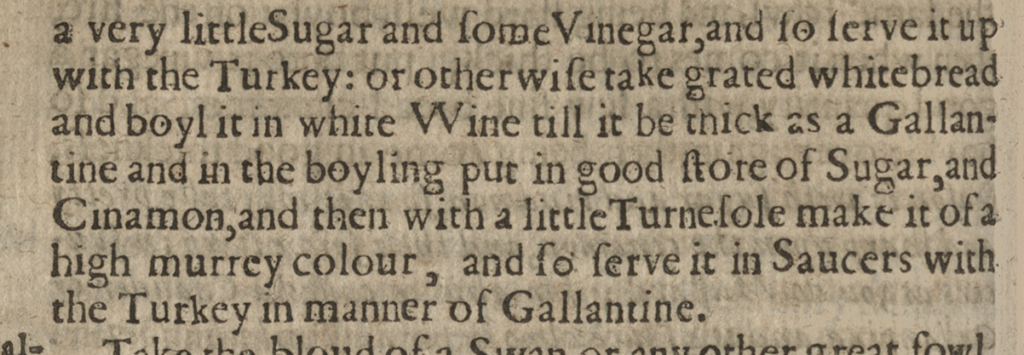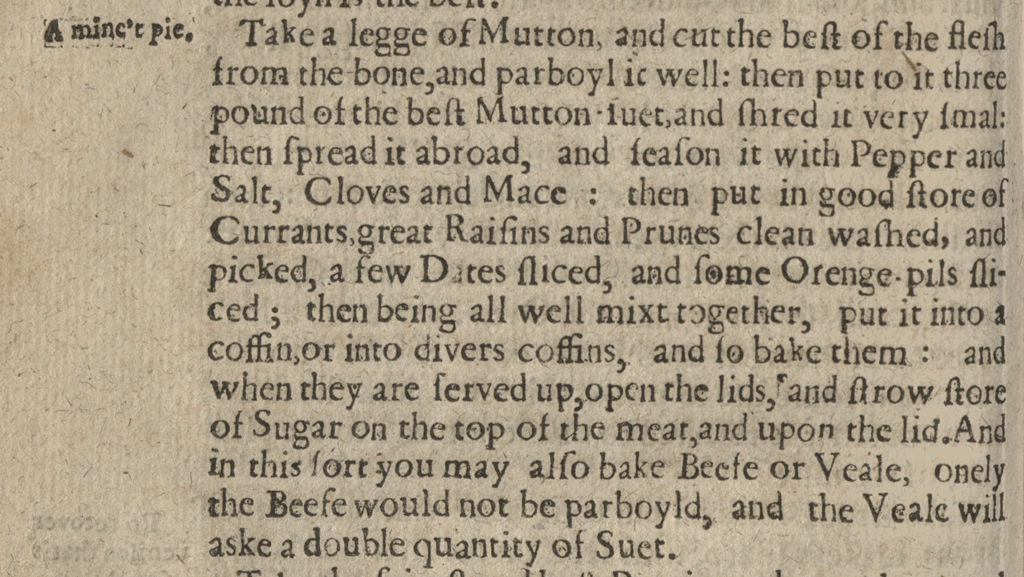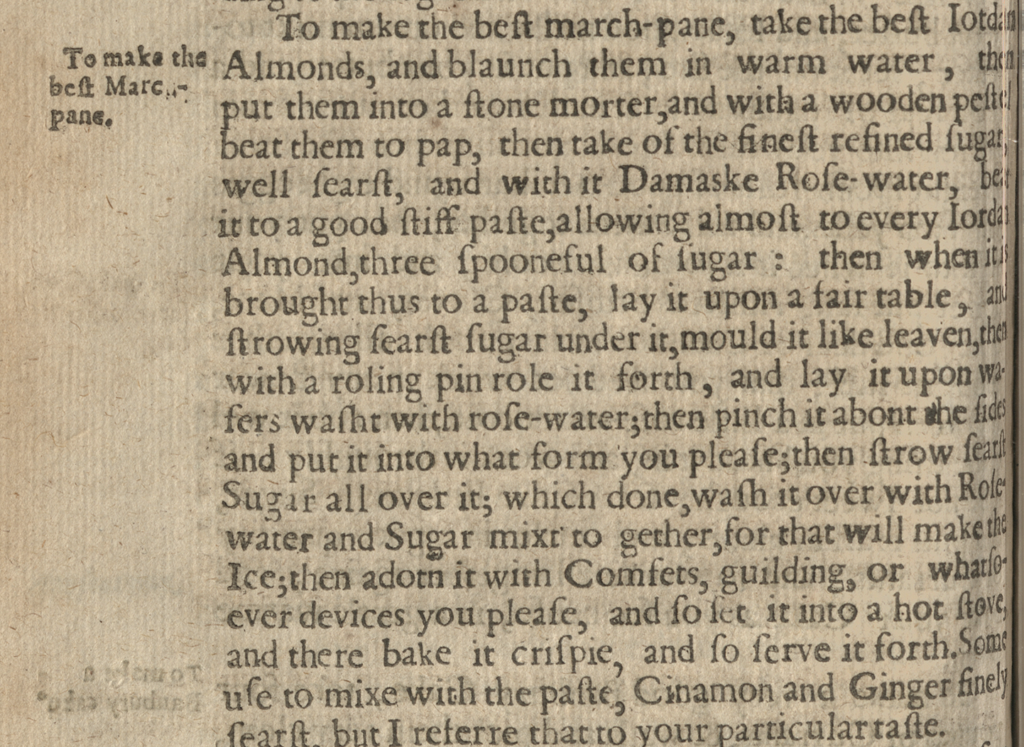
Are you in the midst of preparing an elaborate Christmas meal? How about some inspiration from a seventeenth-century recipe book? From turkey sauces and minced pies to gingerbread and marzipan, Gervase Markham’s The English Housewife (17th Century Collection, 17th C. Coll. 338.1 MAR(3)) contains all the recipes you’ll need to create the perfect early modern festive feast.
About the Author
Gervase Markham was born around the year 1568 into a well-connected country gentry family, although not much is known about his early life. It is possible that, like his elder brother Francis, Gervase was educated at Cambridge. We do know that later, he spent several years serving with his brothers in Ireland and was also somewhat active at court. By 1593, he appears to have settled in London, and it is at this point that he turned his attention to writing.
He penned an astonishing variety of texts spanning multiple genres including poetry, drama and prose alongside a wide range of non-literary works on topics such as horsemanship, veterinary medicine, husbandry, domestic economy and military training.
The English Housewife
First published in 1615, The English Housewife is a handbook that, as its full title suggests, contains ‘all the inward and outward Vertues which ought to be in a compleat Woman’. Markham had an extensive list of demands and expectations when it came to the early modern English homemaker. She should be, above all, ‘of an upright and sincere religion’, and ‘a woman of great modesty and temperance’. She should ‘shunne all violence of rage, passion and humour’, and always remain ‘pleasant, amiable, & delightfull’ towards her husband.
The English Housewife provides recipes, methods, and instructions to help its reader accomplish these lofty expectations by mastering a range of skills including cookery, brewing, baking, perfumery, spinning, dying, and ‘all other things belonging to an Household’. As was customary for recipe books in this period, it also includes treatments for a range of medical ailments and advice on the prevention and cure of everything from the plague to bad breath.
It is worth noting that the contents of the text are not entirely original. Markham specifically credits an unnamed Countess as the source for many of the recipes in the text, and it is likely that many others had been in circulation in manuscript form or communicated orally for many years.
Nevertheless, the handbook remains an invaluable resource offering rare insight into the practicalities of early modern life. It was enormously popular, going through nine editions and at least two additional reprints by 1683. The edition currently held at Newcastle University’s Special Collections and Archives dates from 1649, several years after Markham himself had died.
Whilst not explicitly festive, The English Housewife contains recipes for early versions of many of our holiday favourites. Below you’ll find recipes for minced pies, turkey sauce, gingerbread and ‘marchpane’: everything you’ll need to complete your ‘humble feast’, which, according to Markham, should consist of ‘no less than two and thirty dishes, which is as much as can stand on one table’.
A Sauce for Roast Turkey
Roast turkey will no doubt be the centrepiece on many of our tables this festive season. Take a look at this recipe for an accompaniment for this Christmas staple:
Take fair water, and set it over the fire, then slice good store of Onions, and put into it, and also Pepper and Salt, and good store of the gravy that comes from the Turky, and boyle them very well together: then put to a few fine crums of grated bread to thicken it, a very little Sugar and some Vinegar, and so serve It up with the Turkey: or otherwise take grated whitebread and boyl it in white Wine till it be thick as a Gallantine and in the boyling put in good store of Sugar, and Cinamon, and then with a little Turnesole [turnsole] make it of a high murrey colour, and so serve it in Saucers with the Turkey in manner of Gallantine.
A Recipe for A Minced Pie
These minced pies are quite different to the ones we can buy in supermarkets today. They were more savoury than sweet, and combined meat with dried fruits, sugar and spices. They also were rectangular, rather than round, and were baked into a self-standing pastry known as a ‘coffin’.
Take a legge of mutton, and cut the best of the flesh from the bone, and parboyl it well: then put to it three pound of the best Mutton suet, and shred it very smal: then spread it abroad, and season it with Pepper and Salt, Cloves and Mace: then put in good store of Currants, great Raisins and Prunes clean washed, and picked, a few Dates sliced, and some Orange pils [peels] sliced; then being all well mixt together, put it into a coffin, or into divers coffins, and so bake them: and when they are served up, open the lids, and strow [strew] store of Sugar on the top of the meat, and upon the lid, And in this sort you may also bake Beefe or Veale, onely the Beefe would not be parboyld, and the Veale will aske a double quantity of Suet.
A Recipe for Gingerbread
What Christmas would be complete without gingerbread? Here you’ll find a recipe for spiced gingerbread made with liquorice, aniseed and cinnamon:
Take Claret wine and colour it with Townesall [turnsole], and put in sugar and set it to the fire, then take wheat bread finely grated and sifted, and Licoras [liquorice], Aniseeds, Ginger and cinamon beaten very small and searsed [sieved] and put your bread & your spice altogether, and put them into wine and boyle it & stir it till it be thick: then mould it and print it at your pleasure, and let it stand neither too moist nor too warme.
A Recipe for ‘Marchpane’
Marchpane was early version of marzipan. Like modern marzipan, it was made using ground almonds and sugar. For the Tudors and the Stuarts, no banquet was quite complete without it. It could be carved into elaborate shapes and covered in gilding to create a glamorous centrepiece. According to Markham, it should have ‘the first place, the middle place, and the last place’ of a banquet. For our last recipe, take a look at the work that went into preparing this luxurious dish:
To make the best march-pane, take the best Iordan [Jordan] Almonds, and blaunch them in warm water, then put them into a stone morter, and with a wooden pestel, beat them to pap, then take of the finest regined sugar, well searst [seived], and with it Damaske Rose-water, beat it to a good stiff paste, allowing almost to every Iordan Almond, three spooneful of sugar: then when it is brought thus to a paste, lay it up a fair table, and strowing [strewing] searst sugar under it, mould it like leaven, then with a roling pin role it forth, and lay it upon wafers washt with rose-water; then pinch it about the sides and put it into what form you please; then strow searst Sugar all over it; which done, wash it over with Rose-water and Sugar mixt to gether, for that will make the Ice, then adorn it with Comfets, guilding, or whatsoever devices you please, and so set it into a hot stove, and there bake it crispie, and so serve it forth. Some use to mixe with the paste, Cinamon and Ginger finely searst, but I referre that to your particular taste.
Further Reading
Steggle, Matthew. “Markham, Gervase (1568?–1637), author.” Oxford Dictionary of National Biography.
Best, Michael R., (ed.), Markham G., The English Housewife. Montréal: McGill-Queen’s University Press, 2014.
Historic UK – The history of mince pies
The Past is a Foreign Pantry – Marchpane: 1615
Food52 – Tudor(ish) Marchpane Cake recipe





